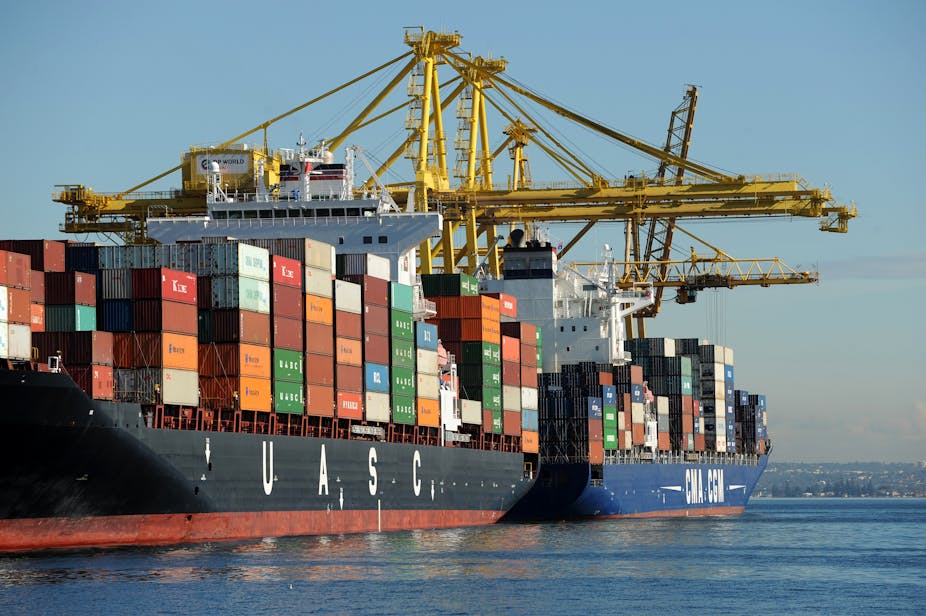Treasurer Joe Hockey has spent much of the year – certainly since the G20 finance ministers’ conference in Sydney – talking up “capital recycling”. The idea sounds promising: new projects can be built without any new money being raised through new taxes or fees or debt.
But how does this actually work, and will asset recycling really result in new infrastructure investment?
The concept of capital recycling seems to have been borrowed from property portfolio management where proceeds from sales of some properties in a portfolio are used to finance purchases of new properties, similar to how share investors might rebalance a share portfolio without adding additional financing.
The basic idea with public infrastructure portfolios is the same: sell or lease existing public assets – like ports – to a private buyer and reinvest the sale revenues into new assets like roads.
Infrastructure Australia likes this idea: “Governments at all levels need to consider how to maximise the value of their infrastructure portfolio – is it by owning and operating all of the assets currently held, or by transferring the capital value of suitable assets to invest in new, priority infrastructure,” it asks.
The World Economic Forum is also supportive: “Consider capital recycling … as an effective strategy to attract private capital while bringing new infrastructure online,” it suggests.
Capital recycling seems rather like selling the family antiques and using the money to build a new addition on to the house. This raises three questions: how much money can be raised in this way, is any “new” capital being contributed to the system, and what are the pitfalls?
Show me the money
The answer to the first question, how much money could be raised, has been estimated at a number of different levels depending on which assets are included in the calculation. In 2012, Infrastructure Australia estimated the value of various government-owned infrastructure assets at between A$116 billion and A$139 billion. A more extensive list compiled by the Australian Financial Review recently put the figure at A$220 billion.
This is a lot of money, but it isn’t new. Things of value are simply being liquidated into cash to be spent on something else. Analogously, you might enjoy your new house extension but you can no longer enjoy the antiques you sold.
But infrastructure is bit different than personal assets. Older facilities may have exhausted most of their returns and there may be cases where “mature” assets, such as ports, would be better privatised so proceeds can be reinvested in new areas, such as urban arterial roads, where need is greater and yields higher.
Infrastructure Australia provides a number of examples to support this view, such as the sale of Port Kembla and Port Botany for A$5 billion to be reinvested in new motorways and regional infrastructure.
Public assets may also be more efficiently run by the private sector and a sale of existing publicly-owned facilities could increase returns even on “mature” facilities. The Business Council of Australia emphasises this point in particular. While capital recycling does not add any new money to the system, it might create greater economic return if done carefully.
No guarantee
It sounds good, but there are inevitably potential problems. For a start, there is no guarantee that money from asset sales will actually go back into infrastructure. Analysis undertaken by Ernst & Young notes that past asset sales have gone into various purposes besides infrastructure, including health and education initiatives.
One solution to this is “hypothecation” of sale revenues, which is a guarantee that there will be reinvestment in infrastructure. Of course promises can be broken, which is one reason the BCA suggests establishing dedicated “Special Purpose Vehicles” for managing proceeds.
Another potential issue is that any asset sale involves giving up public control, including the right to collect any future user fees. In the hunt for quick money, it must always be remembered that even if taxpayers are not hit up initially, the users of the infrastructure will be in the end.
If sales are not structured with public interests in mind, some transactions can end up with higher user charges and possibly adverse social equity effects.
Finally, some states, such as NSW, have more public assets than others, like Victoria. This means recycling has uneven revenue potential across states, a reservation raised in connection with Treasurer Joe Hockey’s recent initiative to incentivise such sales.
Notwithstanding various implementation issues, the thrust of capital recycling is simple: better to exchange low yielding shares for higher yielding ones and have the funds managed by a talented professional. But, of course, this is always most easily done with hindsight.

